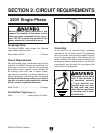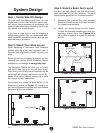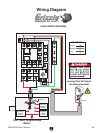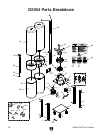
G5954 5HP Dust Collector
-17-
3. Directional changes should be kept to a mini-
mum. The more directional change fittings
you use directly increases the overall resis
-
tance to airflow.
4. Gradual directional changes are more effi-
cient than sudden directional changes (i.e.
use the largest corner radius possible when
changing hose or pipe direction).
5. Each individual branch line should have a
blast gate immediately after the branch to
control suction from one machine to another.
6. The simpler the system, the more efficient
and less costly it will be.
Step 4. Determine Required CFM of
Each Machine
Since each machine produces a different amount
of sawdust, the requirements for the minimum
amount of CFM to move that sawdust is unique
to the machine (for example, a planer produces
more sawdust than a table saw). Knowing this
required CFM is important to gauging which size
of duct to use.
Figure 16 will give you a close estimation of the
airflow your machine requires. Keep in mind that
machines that generate the most sawdust should
be placed closest to the dust collector. If the
machine has multiple dust ports, the total CFM
required is the sum of all ports.
Figure 16. Approximate required airflow for
machines, based on dust port size.
Machine
Dust Port Size
Approximate
Required CFM
2" 98
2.5" 150
3" 220
4" 395
5" 614
6" 884
7" 1203
8" 1570
9" 1990
10" 2456
If your machine doesn't have a built in dust port,
use Figure 17 to determine which size of dust
port to install on your machine.
Machine Average Dust Port Size
Table Saw .....................................................
4"
Miter/Radial-Arm Saw ...................................
2"
Jointer (6" and smaller) .................................
4"
Jointer (8"-12") ..............................................
5"
Thickness Planer (13" and smaller) ..............
4"
Thickness Planer (14"-20") ............................
6"
Shaper ...........................................................4"
Router (mounted to table) .............................
2"
Bandsaw ........................................................4"
Lathe..............................................................4"
Disc Sander (12" and smaller) ......................
2"
Disc Sander (13-18") .....................................
4"
Belt Sander (6" and smaller) .........................
2"
Belt Sander (7"-9") ........................................
3"
Edge Sander (6" x 80" and smaller) ..............
4"
Edge Sander (6" x 80" and larger) ................
5"
Drum Sander (24" and smaller) ..............2 x 4"
Drum Sander (24" and larger) .................4 x 4"
Widebelt Sander (18" and smaller) ...............
5"
Widebelt Sander (24"–37" single head) ..2 x 6"
Widebelt Sander (24"–51" double head) .5 x 4"
Figure 17. Dust port size and quantity per
average machine.
Figure 18. CFM requirements labeled for each
machine.
Write the required CFM for each machine on your
sketch, as shown in
Figure 18.


















